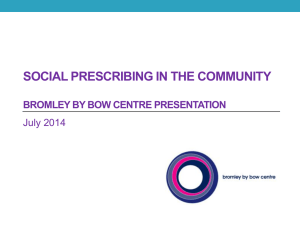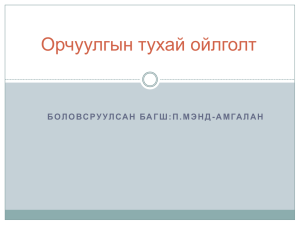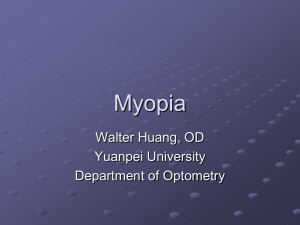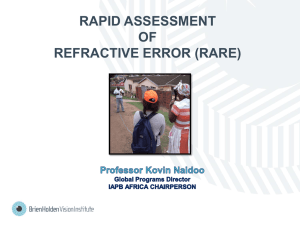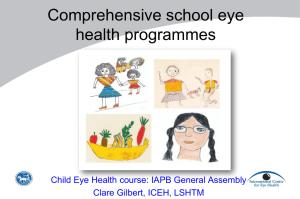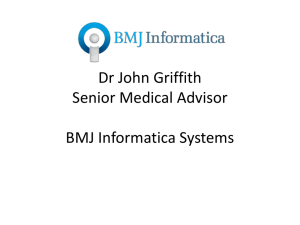2 Prof Clare Gilbert_Improving Efficiency of Vision Testing
advertisement
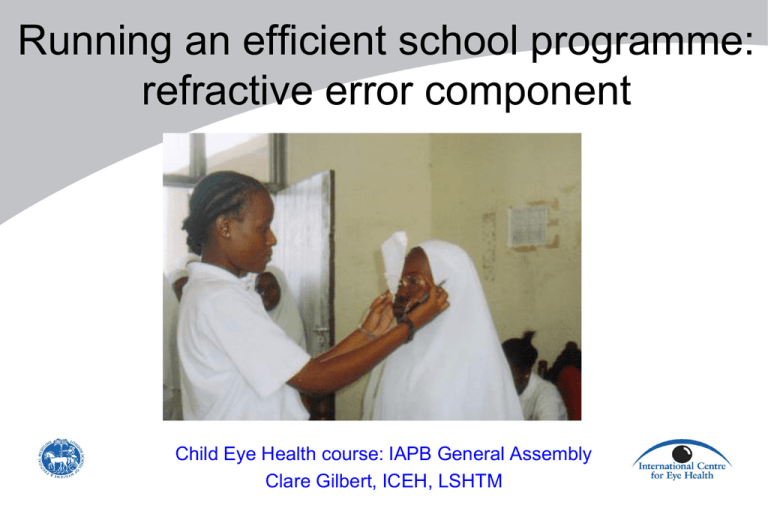
Running an efficient school programme: refractive error component Child Eye Health course: IAPB General Assembly Clare Gilbert, ICEH, LSHTM School eye health programmes: questions that need to be addressed Is a school eye health programme indicated? • prevalence of uncorrected refractive errors • prevalence of endemic diseases e.g. VADD; trachoma • resources available Age at which vision should be tested? Which schools should be included? How often should vision be tested? Who will measure the vision? What chart should be used? What should the cut-off visual acuity be? Should each eye be tested separately? School eye health programmes – questions that need to be asked for uRE Who should refract, where and how? Should prescribing guidelines be used? How will children needing glasses get them? What about children found with other eye conditions? What factors influence spectacle wearing rates and how can wearing rates be improved? Are ready-made / self-adjusting spectacles suitable? How will it be monitored and evaluated? How can quality be assured? Will the programme be cost effective? School eye health programmes – questions that need to be asked for uRE Who should refract, where and how? Should prescribing guidelines be used? How will children needing glasses get them? What about children found with other eye conditions? What factors influence spectacle wearing rates and how can wearing rates be improved? Are ready-made / self-adjusting spectacles suitable? How will it be monitored and evaluated? How can quality be assured? Will the programme be cost effective? Will it make any difference to childrens’ lives? School eye health programmes: questions that need to be addressed Is a school eye health programme indicated? • prevalence of uncorrected refractive errors • prevalence of endemic diseases e.g. VADD; trachoma • resources available Age at which vision should be tested? Which schools should be included? How often should vision be tested? Who will measure the vision? What chart should be used? What should the cut-off visual acuity be? Should each eye be tested separately? Prevalence and types of uncorrected RE in children A neglected area until recently VISION 2020 Refractive Error Working Group – recommended standardised surveys – results from 8 standard surveys now available More data available other studies Still to be determined: – Global importance of RE as a cause of blindness and visual impairment in children Prevalence of visual impairment (acuity <6/12 in one or both eyes)(REWG) 20 Uncorrected Presenting Best corrected 15 10 5 0 C hi na ru ra C hi l na ur ba n In di a ru ra In l di a ur ba N n ep al ru ra M l al ay si a (U ) C hi le (U S ) Af ri c a (U ) Prevalence (%) 25 Prevalence of visual impairment (acuity <6/12 in one or both eyes) Uncorrected Presenting Best corrected 20 15 10 Met need Unmet need 5 0 C hi na ru ra C hi l na ur ba n In di a ru ra In l di a ur ba N n ep al ru ra M l al ay si a (U ) C hi le (U S ) Af ri c a (U ) Prevalence (%) 25 Refractive errors as a cause of visual impairment Refractive error 100% Amblyopia Other 80% 60% 40% 20% 0% China rural China urban India rural India urban Nepal Malaysia Chile South Africa Tanzania S Data from other studies Asian school children 7-9 years [Saw] • Myopia • Malays in Singapore • Chinese Singapore ≥0.5D 22%; in Malaysia 40%; in Malaysian Malaysian primary school children [Hashim] • Criteria • All children <6/12 uncorrected 8% Chinese children in rural junior schools [He] • Criteria • All children ≥6/12 uncorrected 17% 9% 31% Data from other studies Different ethnic groups in the UK aged 10-11 years [Rudnicke] • • • • Myopia & VA ≤6/9 South Asian Black African Caribbean European 25% 10% 3% Tanzania, rural primary school attendees aged 7-19 year [Wedner] • <6/12 in both eyes 0.6% • <6/12 in one eye 0.4% India: urban population (retinoscopy findings) Age (yrs) Myopia ≥ -0.5D Myopia (D) % (95% CI) Hyperopia (D) % (95% CI) China: urban population (retinoscopy findings) Age (yrs) Myopia ≥ -0.5D Myopia (D) % (95% CI) Hyperopia (D) % (95% CI) South Africa: semi-urban pop (retinoscopy findings) Age (yrs) Myopia (D) % (95% CI) Hyperopia (D) % (95% CI) 1% had the potential to benefit from spectacles Summary of evidence Regional differences in prevalence: Asia > Europe/Latin America > Africa low prevalence in Africa may not justify the RE component of school eye health programme Type of refractive error and age: myopia increases with age hypermetropia decreases with age Urban / rural differences: myopia more common in urban areas Which schools and how often? In Asia focus on: • middle/secondary schools • urban then rural schools (unmet need high even in urban areas) South Asia: • include primary school children Africa: • pilot studies and decide if a good use of resources Frequency of visits: • No evidence • ? every 2-3 years if prevalence <5% and but 1-2 years if prevalence >5% School eye health programmes: questions that need to be addressed Is a school eye health programme indicated? • prevalence of uncorrected refractive errors • prevalence of endemic diseases e.g. VADD; trachoma • resources available Age at which vision should be tested? Which schools should be included? How often should vision be tested? Who will measure the vision? What chart should be used? What should the cut-off visual acuity be? Should each eye be tested separately? Measuring visual acuity Teachers measuring visual acuity in school children in Brazil Measuring visual acuity Teachers are used in many programmes Can reliably test in the short term • in China: 85% sensitivity and specificity [Sharma] How do they perform long term? What criteria make good VA testers? How can their motivation be maintained? Also trainee optometrists and nurses; army cadets Sharma A. Strategies to improve the accuracy of vision measurement by teachers in rural Chinese secondary school children. Arch Oph 2008 1434-40 School eye health programmes: questions that need to be addressed Is a school eye health programme indicated? • prevalence of uncorrected refractive errors • prevalence of endemic diseases e.g. VADD; trachoma • resources available Age at which vision should be tested? Which schools should be included? How often should vision be tested? Who will measure the vision? What chart should be used? What should the cut-off visual acuity be? Should each eye be tested separately? Vision testing Cut off options: Chart options: Eyes: 6/9 or 6/12 Full chart vs relevant row Separately vs together Cut off options: • 6/9: many false positives which can overload the system • 6/12: more likely to find significant myopia/astigmatism • Both can miss hypermetropia Chart options: • one row is quicker. • more care with quality control Uniocular vs binocular VA screening in Tanzania Methods: Secondary school pupils (n=2,379; 12-23 yrs) tested with full Snellen: each eye separately and both eyes together Refracted if <6/9 in one eye or <6/9 testing binocularly RE needing correction (in better seeing eye) defined as: – myopia -1.0D or more – hypermetropia +3.0D or more – Astigmatism cyl 1.5D or more Results: <6/12 both eyes had highest PVP (71.4%) & PNV (99.7%) Shilio B. MSc dissertation, ICEH. 2000 VA tested, age and rates of refraction and prescribing Prescribed glasses Country India 1993-7 [Limburg] S Africa [Congdon] Mexico [Holgiun] China [Li] Mozambique [Roba] Tanzania [Wedner] VA tested N tested R and/or L <6/9 5.39m Age group Refracted Of those refracted Overall 6-15 205,000 (4%) 24% 0.8% ≤6/12 8,500 6-19 2,120 (25%) 38% 9.5% ≤6/12 10,096 6-18 5,772 (57%) ND ND ≤6/12 1,892 11-15 960 (50%) 70% 28% <6/9 10,320 5-15 3% 67% 1% <6/12 6,900 11+ ND ND 1.8% Influence of age at VA testing in India (<6/9) Schools Prescribed glasses Of Overall refracted 24.4% 0.8% Age group N tested Refracted All 6-15 5.39m 205,000 (3.8%) Middle 11-15 3.23m 148,200 (4.6%) 26.5% 1.2% Primary 6-10 2.16m 56,900 (2.6%) 19.0% 0.5% Only 1 in 200 primary school children tested at <6/9 were prescribed glasses compared with 1 in 83 middle school children School eye health programmes – questions that need to be asked for uRE Who should refract, where and how? Should prescribing guidelines be used? How will children needing glasses get them? What about children found with other eye conditions? What factors influence spectacle wearing rates and how can wearing rates be improved? Are ready-made / self-adjusting spectacles suitable? How will it be monitored and evaluated? How can quality be assured? Will the programme be cost effective? Will it make any difference to childrens’ lives? Refraction, prescribing and dispensing Refraction: Lots of options: ideal = high quality refraction done at the same time as VA testing, preferably at the school, to improve uptake Prescribing and dispensing: Lots of options: ideal = only children who will really benefit are dispensed high quality spectacles, using prescribing guidelines to prevent over prescribing Should not treat the myopia, but functional impairment arising from it. Type of RE and protocols for prescribing Country Type of prescription (RE) Protocols for prescribing India No data S Africa 60% none (<+/-0.5D); 35% myopia; 5% hyperopia Yes ? Followed Mexico 85% myopia; 10% no RE; 5% hyperopia No data China No data Yes Tanzania 86% myopia ? Up to local optom No data School eye health programmes – questions that need to be asked for uRE Who should refract, where and how? Should prescribing guidelines be used? How will children needing glasses get them? What about children found with other eye conditions? What factors influence spectacle wearing rates and how can wearing rates be improved? Are ready-made / self-adjusting spectacles suitable? How will it be monitored and evaluated? How can quality be assured? Will the programme be cost effective? Will it make any difference to childrens’ lives? Spectacle wearing/carrying rates Country Wearing/carrying rates India 93% (? >100% some areas) Independent variables associated with wearing spectacles No data S Africa 31% Females Mexico 47% (13% wearing) Higher myopic; rural; younger children China 35% purchased specs 24% wearing specs Higher myopia; worse presenting VA; willingness to pay Tanzania 47% if given free specs (trial) 26% if given prescription Higher myopia; worse presenting VA China (trial) Intervention group of students: lower wearing rates Types of spectacles prescribed/given Mexico: very low spectacle wearing rates when children all given the same round framed spectacles. Increased when more variety provided Role of self- adjusting spectacles or ready-made spectacles Other types of spectacles Self correction: Accuracy of refraction using “Adspecs” in China: VA corrected with Adspecs lower than with standard methods, but were within 1 line in 98% of students [Zhang and Congdon] Ready made spectacles: Up to 70% of adults have potential to benefit (pop based surveys); in a clinical trial of adults ready made spectacles compared favourably with custom made. O studies in children [Keay and Friedman] Barriers to spectacle wearing Mexico (1 reason given) Tanzania (FGDs) China (q’aire) Forgot them Appearance /teasing No felt need Appearance /teasing Parents fear VA will decline Make eyes “weak” Broken / lost Mistrust of opticians Parents not involved Use occasionally Prefer diet and traditional remedies Cost No improvement in VA Not a health priority Conspiracy theories Cost School eye health programmes – questions that need to be asked for uRE Who should refract, where and how? Should prescribing guidelines be used? How will children needing glasses get them? What about children found with other eye conditions? What factors influence spectacle wearing rates and how can wearing rates be improved? Are ready-made / self-adjusting spectacles suitable? How will it be monitored and evaluated? How can quality be assured? Will the programme be cost effective? Will it make any difference to childrens’ lives? Monitoring and evaluation Some real M&E data..... Are programmes cost effective? Methods: Mathematical simulation of annual screening for 10 years using six different screening strategies Outcome: international $ / DALY averted Results: Most cost effective strategy: screening 11–15 year olds Cost per DALY averted: $ 67 in Asia to $ 458 in Europe Incremental cost for 5–15 yr olds: $ 111 in Asia to $ 672 in Europe Conclusions: Screening of school children for refractive error is economically attractive in all regions in the world. Baltussen et al. Cost-effectiveness of screening and correcting refractive errors in school children in Africa, Asia, America and Europe. Health Policy 2008 Suggestions for RE based on available evidence 1 Is a programme indicated? 1. Yes: urban schools in all areas but Africa, where pilot studies needed 2. Possibly: rural schools in Asia and Latin America - need pilot studies 3. Probably not: rural schools in Africa unless there is a high prevalence of trachoma etc Prevalence criteria for uncorrected RE: ? ≥2%. Depends on available resources; competing demands; prevalence of other eye conditions Suggestions for RE based on available evidence 2 Age group: children aged 10/11 years to 15 years. Not younger VA testing: teachers OK in short term <6/12 with available correction with both eyes open, but needs more evidence that important pathology is not missed in worse eye Prescribing: clear protocols need to be used and enforced to increase compliance and reduce over prescribing: Suggestions for RE based on available evidence 3 Prescribing: According to guidelines to prevent over prescribing of children with minimal RE Dispensing: fashionable, acceptable frames at the school, if possible Charging: depends on local situation must be affordable Health education: essential: to dispel myths and increase compliance parents must be included What I would not advocate for RE Including children 6-10 years, except in China: - prevalence is low - measuring vision is difficult <6 years - prescribing my interfere with emmetropization in young children - too late to treat/prevent amblyopia Using trained eyecare staff to measure vision Using better level of vision as the cutoff, or unilateral testing - many false positives - over prescribing of spectacles - increases cost More evidence is badly needed Impact of programmes • do spectacles for low myopia improve function and quality of life? • does spectacle wearing improve school attendance/performance? • is there any harm from bullying/teasing for wearing glasses? Optimal screening VA Increasing compliance • what are optimal protocols for prescribing spectacles? • what is the most effective health education strategy? Factors which promote sustainability: • % of need that could be met by ready-made spectacles • willingness to pay School health initiatives UNICEF’s Child Friendly School Initiative WHO Global School Health Initiative : Health Promoting Schools United Nations Girls Education Initiative (UNGEI) UNESCO Partnership for Child Development World Bank Millennium Development Goals Integration Work with Ministries of health / education so that • eye health is part of broader school and child health • schools are safe and healthy places • children learn about eye health Should not be a stand alone, vertical program that only deals with refractive error
